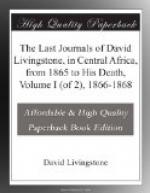8th July, 1867.—Kasonso found an excuse for not going himself. Two men, Arabs it was said, came to Chibue’s and were there killed, and Kasonso must go to see about it. The people who go carry food with them, evidently not intending to live by plunder this time.
While the peacemakers are gone I am employing time in reading Smith’s ‘Bible Dictionary,’ and calculating different positions which have stood over in travelling. I don’t succeed well in the Baeulungu dialect.
The owners of huts lent to strangers have a great deal of toil in consequence; they have to clean them after the visitors have withdrawn; then, in addition to this, to clean themselves, all soiled by the dust left by the lodgers; their bodies and clothes have to be cleansed afterwards—they add food too in all cases of acquaintanceship, and then we have to remember the labour of preparing that food. My remaining here enables me to observe that both men and women are in almost constant employment. The men are making mats, or weaving, or spinning; no one could witness their assiduity in their little affairs and conclude that they were a lazy people. The only idle time I observe here is in the mornings about seven o’clock, when all come and sit to catch the first rays of the sun as he comes over our clump of trees, but even that time is often taken as an opportunity for stringing beads.
I hear that some of Nsama’s people crossed the Lovu at Karambo to plunder, in retaliation for what they have suffered, and the people there were afraid to fish, lest they should be caught by them at a distance from their stockades.
The Baeulungu men are in general tall and well formed, they use bows over six feet in length, and but little bent. The facial angle is as good in most cases as in Europeans, and they have certainly as little of the “lark-heel” as whites. One or two of the under front teeth are generally knocked out in women, and also in men.
14th July, 1867.—Syde added to his other presents some more beads: all have been very kind, which I attribute in a great measure to Seyed Majid’s letter. Hamees crossed the Lovu to-day at a fordable spot. The people on the other side refused to go with a message to Nsama, so Hamees had to go and compel them by destroying their stockade. A second village acted in the same way, though told that it was only peace that was sought of Nsama: this stockade suffered the same fate, and then the people went to Nsama, and he showed no reluctance to have intercourse. He gave abundance of food, pombe, and bananas; the country being extremely fertile. Nsama also came and ratified the peace by drinking blood with several of the underlings of Hamees. He is said to be an enormously bloated old man, who cannot move unless carried, and women are constantly in attendance pouring pombe into him. He gave Hamees ten tusks, and promised him twenty more, and also to endeavour to make his people return what goods they plundered from the Arabs, and he is to send his people over here to call us after the new moon appears.




